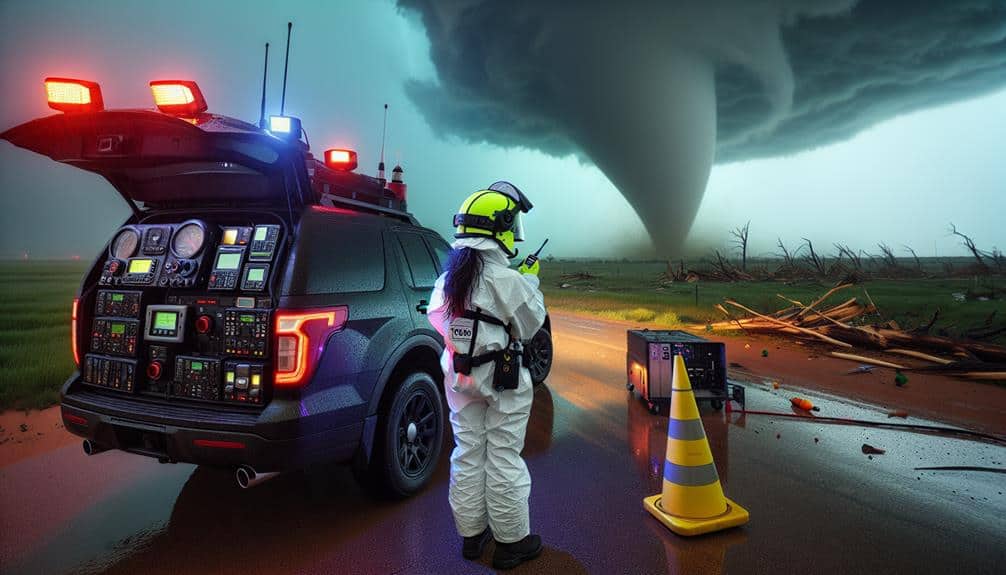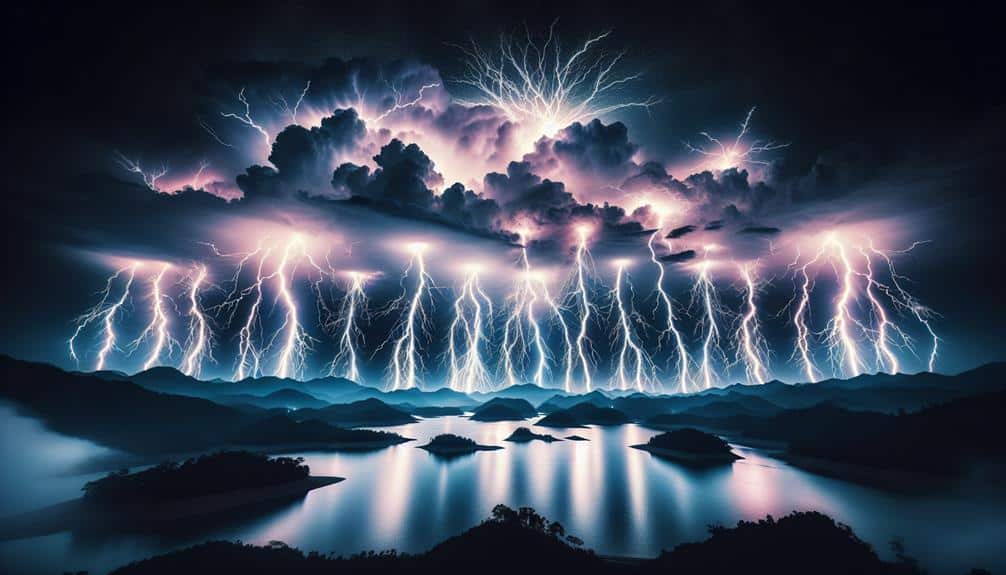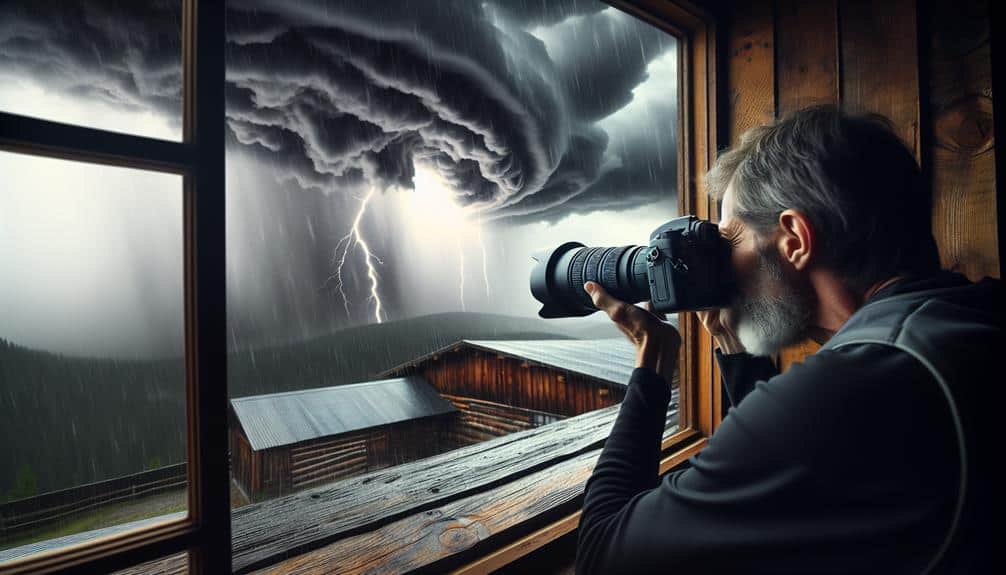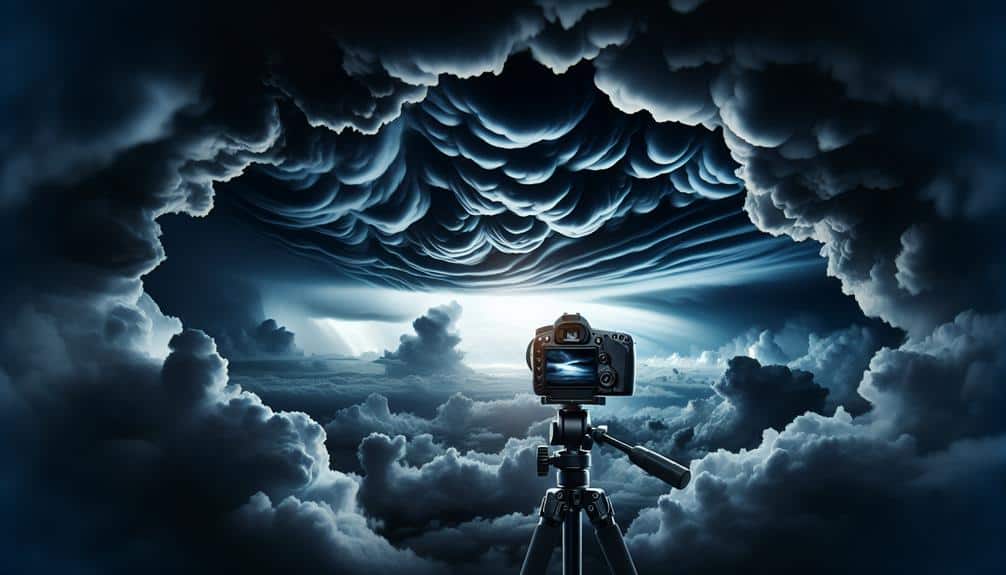We chase tornadoes for the adrenaline rush and the passion to document nature's raw power. By analyzing weather patterns, positioning ourselves strategically, and using advanced photography techniques, we capture stunning visuals that provide valuable insights. Equipped with durable, high-performance cameras and GPS systems, we prioritize safety through robust communication protocols and emergency plans. Despite the risks, calculated preparation and teamwork enable us to face the unpredictability of storms head-on. Our pursuit delivers breathtaking images and essential data, shedding light on these formidable natural phenomena. To uncover the intricacies of storm chasing, let's explore further.
Key Points
- Capturing tornadoes provides a unique and awe-inspiring visual documentation of nature's power.
- The adrenaline rush and excitement drive enthusiasts to chase after extreme weather phenomena.
- High-quality tornado photography can offer valuable insights and education for meteorologists and researchers.
- Tornado chasing requires calculated risks and meticulous safety measures to minimize potential dangers.
The Thrill of the Chase
Chasing tornadoes demands meticulous planning, precise execution, and an unwavering dedication to scientific inquiry. We're driven by the adrenaline rush that comes from witnessing nature's most important forces up close. Each expedition is a calculated gamble—one where high risk meets high reward.
The thrill of capturing extreme photography of tornadoes is unparalleled, a blend of scientific endeavor and raw, unfiltered excitement.
Our pursuit isn't just about the spectacle; it's about understanding these phenomena to better predict and mitigate their devastating impacts. As we track these storms, we navigate complex meteorological data and ever-changing weather patterns. The high-risk nature of our work requires that we constantly assess and reassess our positions, ensuring we stay within safe parameters while still getting the essential data and imagery we seek.
The high reward comes in the form of valuable insights and breathtaking visuals that contribute to both science and public awareness. The images we capture aren't merely for show—they become part of a larger narrative that informs and educates.
This duality of purpose—seeking both knowledge and the perfect shot—drives us forward, fueling our passion and commitment to this exhilarating yet perilous endeavor.
Essential Gear and Tools
To effectively capture tornadoes, we need to prioritize both our photographic equipment and our safety. High-quality cameras and lenses are essential for documenting these powerful events, while reliable navigation tools guarantee we stay out of harm's way.
Let's explore the essential gear that balances our creative objectives with our well-being.
Cameras and Lenses
When selecting cameras and lenses for capturing tornadoes, our primary focus should be on durability, low-light performance, and zoom capabilities. Given the harsh weather conditions, our equipment must withstand rain, dust, and strong winds. Regular equipment maintenance ensures that our gear operates flawlessly, even in these extreme environments.
For lens selection, a versatile zoom lens is vital. We recommend lenses with focal lengths ranging from 24mm to 200mm, providing the flexibility to capture both wide-angle shots of the storm structure and close-ups of the tornado itself. Prime lenses, though offering superior image quality, may limit our compositional freedom during rapidly changing scenarios.
Camera settings play a pivotal role in capturing the dynamic nature of tornadoes. A high ISO capability is essential for low-light performance, allowing us to shoot in stormy conditions without sacrificing image quality. Fast shutter speeds, typically 1/1000th of a second or faster, are necessary to freeze the motion of flying debris and swirling clouds.
While our camera gear is vital for capturing breathtaking tornado footage, prioritizing safety and effective navigation is crucial to ensure we can continue our work without unnecessary risk. Navigational hazards are ever-present in storm chasing. We rely on cutting-edge GPS systems and real-time weather radar to avoid getting stuck in precarious situations. Our vehicles are equipped with advanced communication tools, like satellite phones and two-way radios, guaranteeing we maintain contact with weather stations and fellow chasers.
Adhering to strict safety protocols is vital. We never chase alone; a well-coordinated team multiplies our observational capabilities and enhances decision-making under pressure. Each member is trained in first aid and emergency response, ready to act if the situation demands. Thorough weather briefings before heading out are non-negotiable, providing crucial updates on storm paths, potential flash floods, and other risks.
Personal protective equipment (PPE) is another cornerstone of our safety strategy. From helmets to protective eyewear, PPE shields us from debris and other hazards.
Safety Precautions

When capturing tornadoes, we must prioritize safety by ensuring we've proper gear essentials, an emergency communication plan, and clearly identified shelter and evacuation routes.
We should carry weather-resistant clothing, first aid kits, and reliable communication devices. Additionally, having predetermined safe zones and exit strategies can notably reduce risks.
Proper Gear Essentials
Equipping ourselves with the right gear is vital for safely capturing tornado footage. Gear selection starts with reliable weather-resistant cameras and lenses that can withstand harsh conditions. High-quality tripods are pivotal for stable shots in windy environments. We also need to include a variety of lens filters to adapt to changing light conditions, guaranteeing clear and vibrant images.
Safety precautions extend beyond photography equipment. A sturdy vehicle with reinforced windows and GPS navigation systems is non-negotiable. We should have emergency kits containing first aid supplies, water, and non-perishable food items. Additionally, personal protective equipment like helmets and goggles can prevent injuries from flying debris.
Understanding chasing techniques is just as important. We must constantly monitor weather updates and use radar systems to track storm movements accurately. Positioning ourselves at a safe distance while maintaining a clear line of sight is key.
Photography tips are vital to capturing compelling images. Using a fast shutter speed can freeze the rapid tornado motion, while wide-angle lenses capture the grandeur of the storm. Bracketing exposures ensures we get the perfect shot despite fluctuating light levels.
Emergency Communication Plan
Developing a strong emergency communication plan is crucial for maintaining safety and coordination during tornado chasing expeditions. We need to establish clear communication protocols to make certain that all team members can stay in constant contact. This includes using reliable radios, satellite phones, and backup power sources to keep lines open, even in remote areas where cell service might fail.
Weather tracking and storm prediction are at the core of our operations. By utilizing advanced meteorological tools, we can predict storm paths and potential tornado formations with higher accuracy. This information must be disseminated rapidly among team members through a pre-determined communication hierarchy, guaranteeing that everyone is aware of any changes in the weather conditions.
Our emergency response plan should include regular check-ins at scheduled intervals and an established procedure for reporting emergencies. Every team member should know their specific roles and responsibilities, including who to contact first in case of an emergency. This assures a swift, coordinated response, minimizing risks and maximizing the potential for a successful chase.
In essence, a robust emergency communication plan empowers us to face unpredictable elements with confidence, enhancing both our safety and our freedom to pursue the thrilling endeavor of tornado chasing.
Shelter and Evacuation Routes
As we ensure robust communication, we must also strategically identify shelter and evacuation routes to safeguard our team during tornado chasing expeditions. Effective risk assessment is crucial in our safety planning. We need to evaluate potential hazards in real-time, making sure that everyone knows the designated evacuation procedures and locations of safe shelters.
Our first step involves mapping out multiple evacuation routes. By analyzing weather patterns and terrain, we can anticipate the most likely paths of tornadoes. We then identify nearby structures that meet the criteria for safe shelters. These shelters should be reinforced buildings, preferably underground or with minimal windows, to provide best protection.
During every expedition, we continuously update our risk assessment based on real-time data. We must remain agile, ready to adjust our plans as conditions evolve. This flexibility is essential for our safety planning, as tornadoes can change direction rapidly.
Additionally, we conduct regular drills to ensure our team is well-versed in evacuation procedures. Each member must know their role and the quickest path to the nearest safe shelter. By meticulously planning and practicing these protocols, we maximize our freedom to chase tornadoes while minimizing the inherent risks.
Capturing the Perfect Shot
Mastering the art of capturing the perfect shot of a tornado requires a blend of technical expertise, precise timing, and an acute understanding of weather patterns. The adrenaline rush we experience when we position ourselves in the path of a storm is unmatched. Our primary goal is to utilize advanced photography techniques to document these natural phenomena.
We start by analyzing weather patterns meticulously. Using sophisticated storm tracking techniques, we predict the tornado's path, ensuring we're in the best spot to capture its formation and progression. Timing is essential; a fraction of a second can mean the difference between an iconic shot and a missed opportunity.
Our equipment choices are equally crucial. High-speed cameras with robust zoom lenses allow us to capture the intricate details of the tornado, from the swirling debris to the dramatic funnel cloud. We use tripods to stabilize our shots amid turbulent conditions and employ remote triggers to avoid camera shake.
Challenges Faced by Storm Chasers
Positioning ourselves perfectly to capture the awe-inspiring force of tornadoes, we inevitably encounter numerous challenges that push our skills and equipment to the limit. Navigating unpredictable weather patterns requires precise analysis and real-time adjustments.
The adrenaline rush of chasing these powerful storms can cloud judgment, necessitating meticulous risk assessment to ensure safety without compromising our mission.
Our teamwork dynamics are crucial in these high-pressure situations. Effective communication, trust, and clearly defined roles help mitigate risks and enhance our chances of success. Each team member must understand their responsibilities, from monitoring weather data to driving and capturing footage.
This synergy is vital when seconds can mean the difference between capturing a breathtaking shot and facing a dangerous situation. Equipment reliability is another critical factor. Cameras, GPS systems, and weather tracking tools must function flawlessly under extreme conditions. Malfunctions can lead to missed opportunities or hazardous situations.
Regular maintenance and rigorous testing are essential to our operations. Lastly, the physical and mental toll of storm chasing can't be underestimated. Long hours, sleep deprivation, and high stress levels demand resilience and preparedness.
Despite these challenges, our passion for documenting tornadoes drives us to face these obstacles head-on, always striving for that perfect shot.
Stories From the Field
Often, our field experiences offer priceless lessons that textbooks can't replicate. One vivid memory involves a close call that epitomized the unpredictable nature of storm chasing. We'd positioned ourselves strategically, relying on real-time data and our collective expertise. Within minutes, the storm's path shifted unexpectedly, putting us directly in the tornado's trajectory.
The adrenaline rush was palpable. Swift decision-making and seamless teamwork dynamics were essential as we navigated out of harm's way, narrowly escaping disaster.
Such experiences underscore the importance of adaptive strategies and communication. During another chase, our convoy faced deteriorating weather conditions that scrambled our pre-planned routes. Each team member had to rely on their specialized skills, from radar interpretation to vehicle maneuvering, to recalibrate our approach.
The unpredictable nature of storm behavior demanded that we remain flexible and responsive, ensuring our safety while capturing valuable data.
These stories from the field highlight not just the thrill and inherent risks, but also the profound sense of camaraderie and trust among team members. Our shared commitment to understanding these natural phenomena propels us, pushing the boundaries of what we comprehend and how we adapt in the face of nature's volatility.
Frequently Asked Questions
What Inspired You to Start Chasing Tornadoes?
We started chasing tornadoes due to our passion and curiosity about extreme weather. The thrill-seeking aspect and adrenaline rush fuel our desire for freedom and exploration, allowing us to analyze and understand these powerful natural phenomena.
How Do You Fund Your Storm Chasing Expeditions?
We fund storm chasing expeditions through sponsorship opportunities and crowdfunding. Given the financial risks, we meticulously budget each trip. Did you know? Nearly 40% of our funds come from crowdfunding alone, highlighting our audience's support and enthusiasm.
What Do You Do With the Footage You Capture?
We distribute our footage through various channels, ensuring ethical implications are considered. By sharing with scientific communities, media outlets, and educational platforms, we aim to enhance understanding and awareness while maintaining respect for affected individuals and communities.
How Do You Handle the Emotional Impact of Witnessing Destruction?
We handle the emotional impact by employing coping mechanisms and seeking mental health support. Sharing experiences within our community and accessing professional help guarantees we maintain resilience and continue our mission without compromising our mental well-being.
Are There Any Legal Considerations for Storm Chasing?
We consider privacy issues, liability concerns, environmental impact, and safety precautions seriously. Legal considerations include respecting property rights, avoiding trespassing, minimizing ecological disturbance, and ensuring our actions don't endanger ourselves or others. Freedom requires responsibility.


